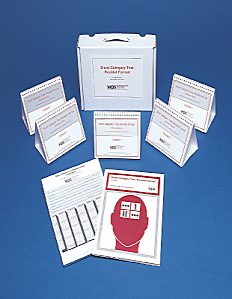| ||||||
|
| |||||||||||||||||||||||||||||||||||||||||||||||||||||||||||||||||||||
| |||
|
|
| |
| |||
| ||||||||
Compact, Convenient Test Materials
The SCT includes five subtests, each in a 5″ x 7″ booklet of 20 Stimulus Cards. As in the original Category Test, the cards show various geometric shapes, lines, colors, and figures. All the cards within each booklet are organized around a single principle.
The client is shown the cards, one at a time. In order to respond correctly, he or she must discern the principle underlying each series of cards. This requires specific mental abilities: abstract concept formation, learning capacity, adaptive skill, and cognitive flexibility. By testing these abilities, the SCT uncovers the important, but often subtle, deficits that are frequently present in brain-damaged individuals.
Although the SCT measures a complex set of abilities, it is quite easy to administer and score. Under appropriate supervision, a paraprofessional can administer all five subtests in just 15 to 30 minutes. The only materials required are the SCT Answer Sheet and the five subtest booklets.
The test can be given to anyone who can see clearly and is alert enough to give a simple one-word response. (Individuals who are language impaired can respond by pointing to numbers on a special card provided with each subtest booklet.) And because the test materials are compact and portable, the SCT is easy to administer at bedside.
Scoring the test requires only a few minutes. Errors are totaled to produce raw scores, which are then converted to T-scores and percentile equivalents.
Diagnostic Power of the Category Test
The SCT functions in a manner very similar to the Category Test–in terms of psychometric properties, discriminative ability, and correlation with other neuropsychological tests. It serves as a sensitive screening device in a variety of medical and mental health settings. Typically, the test is used to:
The SCT gives you the diagnostic power of the Category Test–without its practical limitations.
Component
KIT: Includes 1 Set of Stimulus Cards; 100 Answer Sheets; 1 Manual




